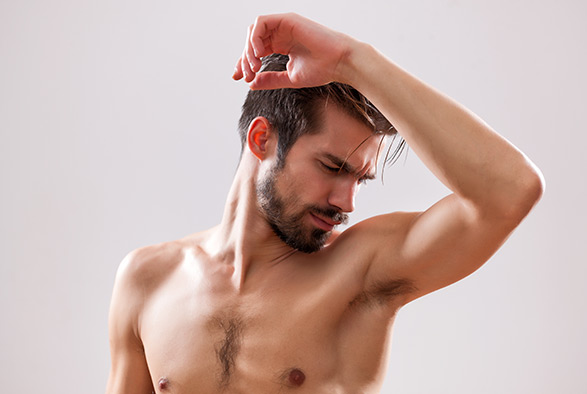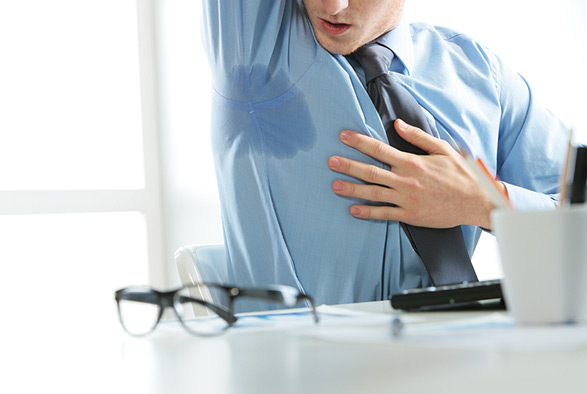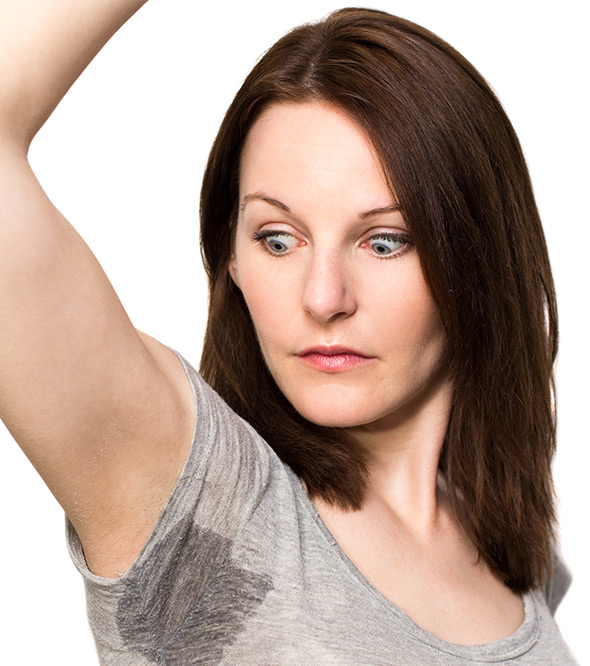What is Hyperhidrosis?
Sweating is a necessary bodily function that regulates body temperature. When sweat evaporates off your skin it cools you down, which is why you sweat when it is hot or when you’re exercising. Some people sweat more than might be necessary to cool their body, which medically is called hyperhidrosis. If you are sweating so much that it is affecting your well being then you may have this condition. Treatment options include prescription-strength antiperspirant, oral medications, Botox injections, iontophoresis, and miraDry electromagnetic energy treatments.
Palms, feet, underarms, and head are the most common areas where hyperhidrosis is evident. Excessive sweating in these areas can lead to spending a lot of time dealing with the sweat. This means changing clothes frequently, avoiding social situations where sweating would be visible, and generally having to go through extra effort to prevent, manage, and clean off sweat.
Treatments for hyperhidrosis often are best for a particular area. Some are more appropriate for treating sweat on the hands and feet while others are only used under the arms. Although the treatments effectively stop sweat in a certain area they do not impact thermoregulation, as the body has millions of sweat glands. For example, only 2-3% of the body’s sweat glands are under the arms.


What is Hyperhidrosis (Excessive Sweating)?
Hyperhidrosis is a condition in which affected individuals sweat excessively, no matter how often they apply – and reapply – antiperspirant. Hyperhidrosis is a very common condition, affecting both men and women equally. To hide this embarrassing condition from others, individuals often resort to wearing dark clothes or changing multiple times each day. Hyperhidrosis can occur nearly anywhere on the body. Patients often complain about excessive underarm sweating, as this is especially noticeable. Hyperhidrosis can be treated in a number of different ways.
How is Excessive Sweating treated?
Topical treatments
that essentially clog the sweat glands may work in mild cases of hyperhidrosis, but are often associated with a stinging or burning sensation upon application.
Pills
Pills for hyperhidrosis are effective, but are often not well tolerated due to common side effects such as dry eyes, dry mouth, flushing, headache, constipation and the inability to urinate.
Botox Therapy
Mild to more moderate cases of hyperhidrosis may respond to Botox therapy, which entails the injection of a bacterial toxin via several needle sticks into each armpit. Possible drawbacks of Botox include that the treatments wear off with time and need to be repeated every 4-6 months. Botox is also not suitable for individuals with neuromuscular disorders such as myasthenia gravis.


MiraDry
miraDry is a new FDA approved procedure to provide lasting results and it does not carry the risks and recovery time associated with surgery. Click here to read more about miraDry.
Iontophoresis
Iontophoresis is another treatment option for hyperhidrosis that involves delivery an electrical current to the area of skin affected by hyperhidrosis. Unfortunately, iontophoresis is not suitable for all areas of the body and cannot be performed on the armpits.
Laser Liposuction
Laser liposuction can also be employed to reduce armpit sweating. It is an invasive, surgical procedure that destroys sweat glands from the heat and scar tissue generated from the procedure.
Thoracic Sympathectomy
The most invasive treatment option for hyperhidrosis of the armpits is a thoracic sympathectomy, which is an invasive surgical procedure that entails cutting the nerve fibers that transmit the signal for sweating. Besides the usual anesthesia risks and complications associated with surgery, the patient’s lungs have to be deflated one-by-one during the procedure to allow the surgeon access to the nerves. Although the procedure works well, patients not uncommonly develop a side effect called compensatory hyperhidrosis, which is excessive sweating elsewhere on the body or even excessive facial sweating when eating certain foods.


Reducing Sweat for Those Without Hyperhidrosis
Sweat may still bother you even if you aren’t diagnosed with hyperhidrosis. Likely you aren’t willing to take medication or get regular Botox injections just to stop using antiperspirant. But maybe you are willing to do a one-time treatment that stops sweating under your arms permanently. Many patients come to Advanced Dermatology, P.C. who do not have hyperhidrosis but just want to stop sweating under their arms. They don’t like having sweat stains on their shirts and having to worry about having sweaty armpits in certain situations. Some don’t like having to wear antiperspirant every day that can also stain their clothes.
If you are suffering from hyperhidrosis, or if you would just like to stop having to wear antiperspirant and worrying about underarm sweat – schedule your consultation with one of the experienced providers at Advanced Dermatology, P.C. today. We have offices throughout New York including Long Island, Queens, Brooklyn, Manhattan, and Westchester and also New Jersey.
Frequently Asked Questions
What is hyperhidrosis (excessive sweating)?
Sweating is the body’s natural regulatory response to a rise in temperature, cooling itself down and preventing you from overheating. Hyperhidrosis is when an individual sweats excessively, even without physical activity, a hot climate or other situations that would normally cause a rise in body temperature. Hyperhidrosis affects many people, causing embarrassment, anxiety, and in some cases, complete avoidance of social situations.
What causes excessive sweating?
Excessive sweating is caused by overactive sweat gland. This is especially pronounced when nervous or under stress. While hyperhidrosis typically affects individuals who are otherwise healthy, it sometimes occurs along with other conditions.
How is hyperhidrosis diagnosed?
Excessive sweating is usually noticeable, making hyperhidrosis relatively easy to diagnose. Lab testing may be done to rule out other conditions, such as as overactive thyroid.
How is excessive sweating treated?
Several treatment options currently exist for excessive sweating:
- Prescription antiperspirants are often the first recommended line of defense against hyperhidrosis, to be applied at bedtime.
- Oral medications are sometimes prescribed to block the nerves. This option is not always pursued, as it may cause undesired side effects.
- Botox injections may be administered to block the nerves responsible for excessive underarm sweating; for best results, these injections need to be repeated regularly. In addition, this treatment option is not always covered by insurance, making it expensive.
- miraDry is a new minimally-invasive procedure to treat excessive underarm sweating. Click here to read more about miraDry.
- Surgery may be performed to remove the sweat glands. As with all surgical procedures, this procedure carries a risk of complications.
Suffering from hyperhidrosis? Don’t sweat it – contact us today!
You do not have to continue suffering from the inconvenience and embarrassment of excessive sweating. Contact us today to schedule a consultation and discuss various treatment options.
